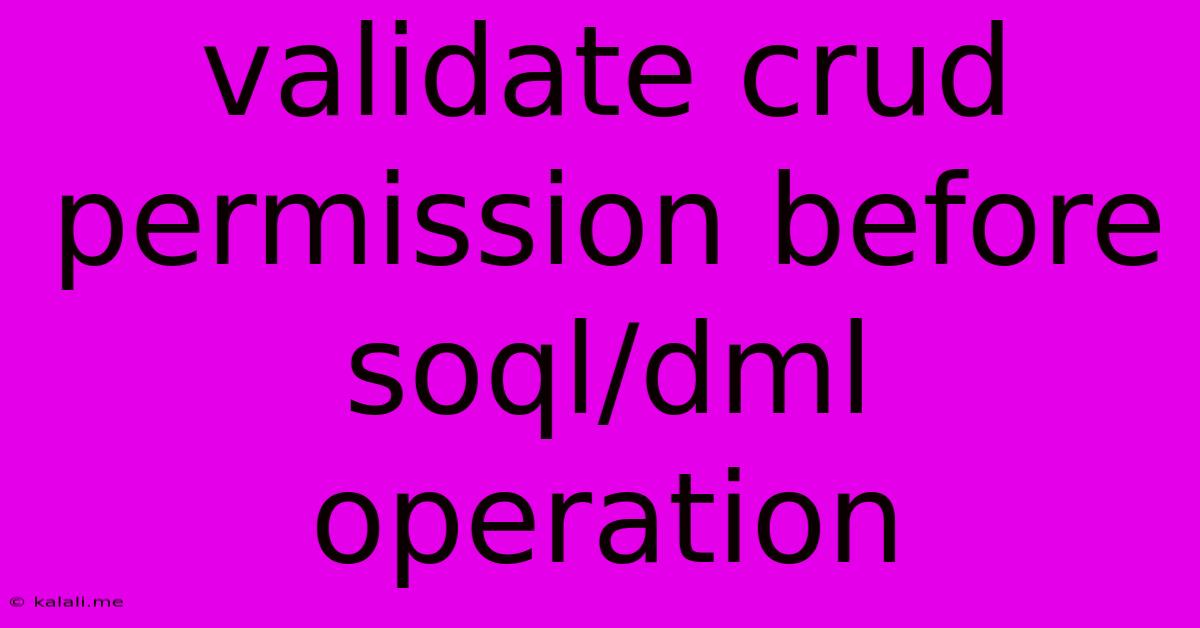Validate Crud Permission Before Soql/dml Operation
Kalali
Jun 03, 2025 · 3 min read

Table of Contents
Validate CRUD Permissions Before SOQL/DML Operations in Salesforce
This article delves into the critical practice of validating CRUD (Create, Read, Update, Delete) permissions before executing SOQL (Salesforce Object Query Language) or DML (Data Manipulation Language) operations in Salesforce. Failing to do so can lead to unexpected errors, data inconsistencies, and security vulnerabilities. This best practice ensures your application behaves predictably and securely, protecting your data integrity.
Why Pre-Validation is Crucial:
Ignoring permission checks before querying or manipulating data opens your application to several risks:
- Unexpected Exceptions: Attempting a DML operation without prior permission validation will result in a runtime exception, crashing your application or causing unexpected behavior. This leads to a poor user experience and potential data loss.
- Security Vulnerabilities: Without proper validation, malicious users could potentially exploit vulnerabilities to access or modify data they shouldn't have permission to. This compromises the security and integrity of your Salesforce org.
- Data Integrity Issues: Unvalidated operations could lead to inconsistencies in your data, potentially causing inaccurate reports and business decisions.
How to Validate CRUD Permissions:
Several approaches exist for effectively validating permissions before SOQL/DML operations. Here are two common and robust methods:
1. Using the Schema.DescribeSObjectResult Class:
This approach leverages the Salesforce metadata API to programmatically check object and field-level permissions. It's particularly useful for determining if a user has the necessary permission to perform a specific action on an object.
//Example Apex Code
Schema.DescribeSObjectResult objectDescribe = YourObject__c.sObjectType.getDescribe();
Boolean hasReadAccess = objectDescribe.isAccessible();
Boolean hasCreateAccess = objectDescribe.isCreateable();
Boolean hasUpdateAccess = objectDescribe.isUpdateable();
Boolean hasDeleteAccess = objectDescribe.isDeletable();
// Further checks for field-level access can be performed.
// For example:
Map fieldMap = objectDescribe.fields.getMap();
Schema.DescribeFieldResult fieldNameResult = fieldMap.get('YourFieldName__c');
Boolean hasFieldReadAccess = fieldNameResult.isAccessible();
This code snippet demonstrates how to check object-level access. You can expand this to include field-level permissions for more granular control. Remember to replace YourObject__c and YourFieldName__c with your actual object and field names.
2. Utilizing Sharing Rules and Apex Security:
Leveraging Salesforce's built-in sharing rules in conjunction with Apex security best practices is another effective method.
- Sharing Rules: Define appropriate sharing rules to control access to records based on criteria like ownership, roles, or profiles.
- Apex Security: Use the
System.debug()to effectively check the sharing model results within Apex. This method helps determine whether a user has access to a particular record based on the defined sharing rules.
Remember that combining sharing rules with direct permission checks using Schema.DescribeSObjectResult can provide the most comprehensive security.
Best Practices:
- Centralized Validation: Create a dedicated utility class to handle permission checks, promoting code reusability and maintainability.
- Granular Control: Validate permissions at the field level whenever possible to ensure fine-grained access control.
- Error Handling: Implement robust error handling to gracefully manage cases where a user lacks the necessary permissions. Provide clear and informative error messages to the user.
- Regular Review: Periodically review your permission validation logic to ensure it aligns with your evolving security requirements.
By incorporating these validation strategies, you bolster the security, reliability, and overall quality of your Salesforce applications. Preventing unauthorized access and data manipulation is essential for maintaining data integrity and protecting sensitive information. Remember, proactive permission validation is a fundamental aspect of secure and robust Salesforce development.
Latest Posts
Latest Posts
-
How To Save All Texture Paintings Blender
Jun 04, 2025
-
Aircon Thermostat 1 To 10 Meaning
Jun 04, 2025
-
Alternatives For Book Of Shadows 5e
Jun 04, 2025
-
Dnd Can Faceless Be Someone Hiding Their Race
Jun 04, 2025
-
Best Books On Modern Monetary Theory
Jun 04, 2025
Related Post
Thank you for visiting our website which covers about Validate Crud Permission Before Soql/dml Operation . We hope the information provided has been useful to you. Feel free to contact us if you have any questions or need further assistance. See you next time and don't miss to bookmark.